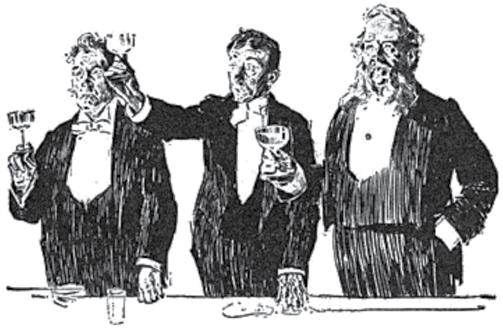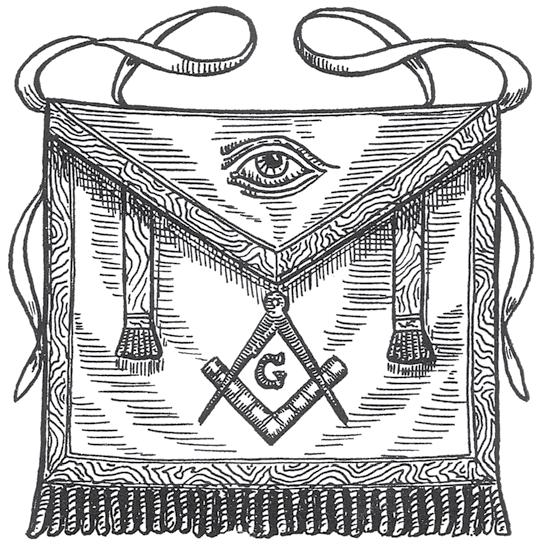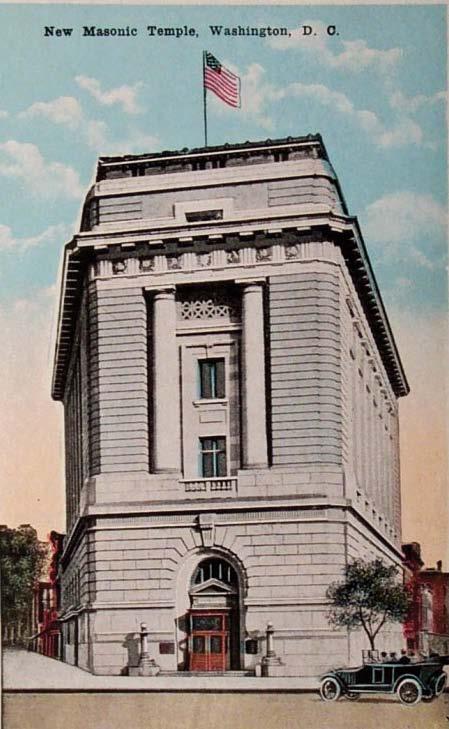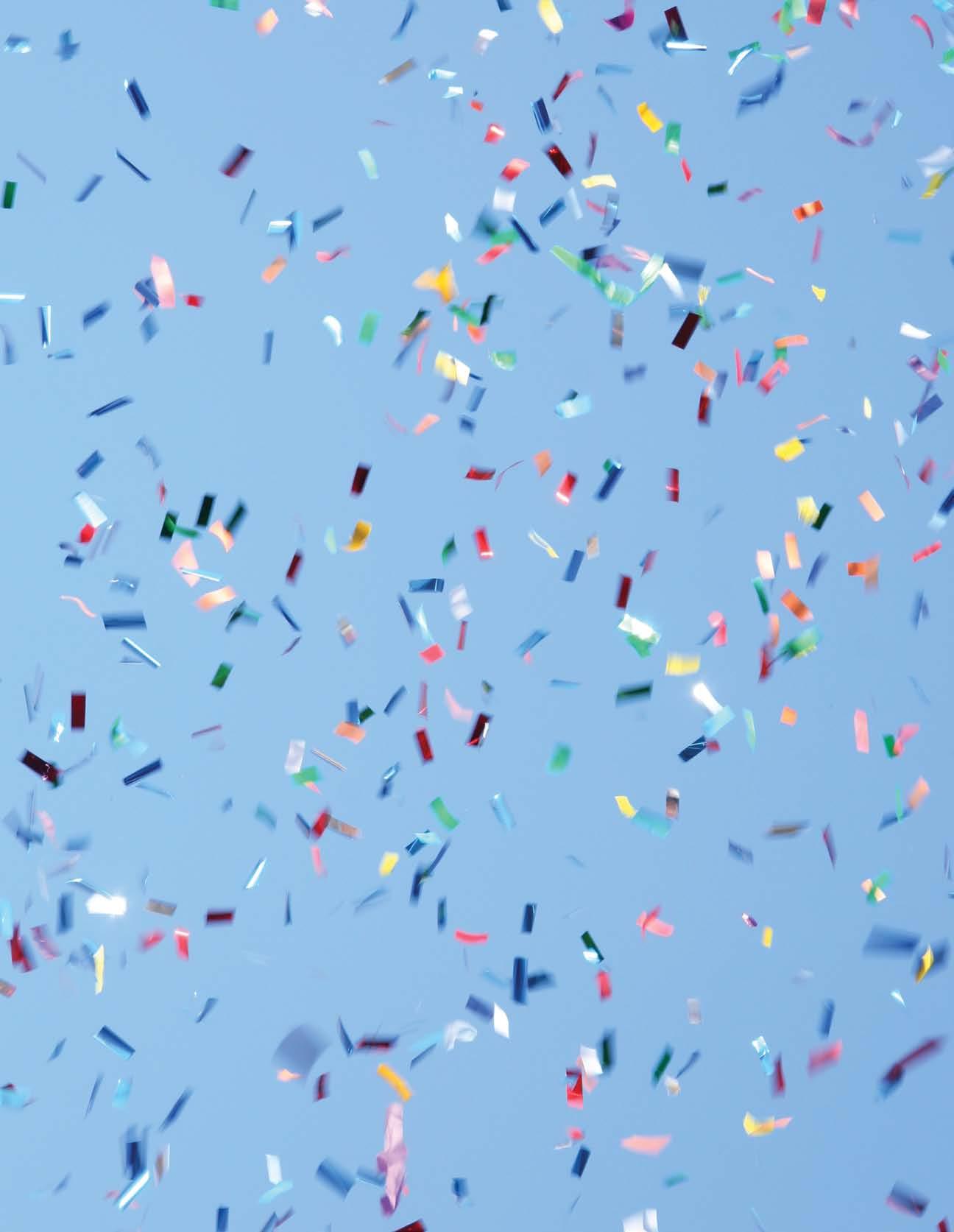
14 minute read
A Continent Apart, but a Bond Unbroken
As I walked off the plane in Colombia, I was greeted by a warm dry breeze that danced off my face as I walked the long corridor that would bring me, Most Worshipful Grand Master Paul Gleason and Most Worshipful Brother George Adams to our waiting Colombian Masonic hosts. Having traveled to Colombia professionally in the past, I faced this trip with trepidation about the unknown and what lie waiting for us over the next four days. My trepidation would soon dissolve into wonderment, intrigue and pride as I experienced one of the finest displays of brotherly love and affection from our hosts.
Over the course of our time in Colombia, our Masonic hosts brought us too many different and wondrous sites in and around Bogotá. Our first visit consisted of taking a tour deep into the side of a hill to view chapels that had been carved deep into salt lines meters below the earth. These chapels emitted a stunning sight to the eyes as rooms and columns grew ever higher within the mine. From deep in the earth, we were brought too many meters above Bogotá to the historic Monserrate, a white church that overlooks Bogotá, almost as if it is a guardian angel gently watching over its flock. We also traveled to several different museums spread across the city to include the Museo de Oro (Museum of Gold) and several museums that exhibited Colombian artwork. These museums presented an astounding history of Colombia and its people. We also had the occasion to dine at the infamous El Nogal Club, the site of a deadly bombing in 1993 by FARC rebels, after the installation of officers for George Washington Lodge No. 17 Without Borders. The restaurant seemed to be a perfect spot to hold the officer’s dinner as it served as a reminder of Bogota’s past, but presented an image of its future.
After my trip to Colombia, I can report that Masonry is alive and well in the world. From the well-thought out questions asked of our Grand Master by the Senior Warden of George Washington Lodge No. 17 Without Borders, to the camaraderie exhibited by the many Masons that attended the consecration that was conducted by our Grand Master for a newly-made
Garrison K. Courtney
Grand Marshal
English speaking lodge in Bogota, the excitement of American Masonry bubbled from the lips, hearts and minds of our Masonic hosts and they busily asked our Grand Master and Most Worshipful Master Adams about the ideas of philanthropy, philosophy and even astrology and their Masonic applications at each event we attended. Our Colombian counterparts left no stone unturned as they eagerly devoured the ideals and motivations of Masons within the District of Columbia. A dropped pin could have shattered the deafening silence of the lodge room as the voices of our Grand Master, MWB Adams and I conducted the opening and closing of the newly consecrated lodge. Our small visit to Colombia has left a mighty imprint on the minds of Masons in two continents, especially mine, confirming my belief that Masonry is not dying, but was lying dormant until its thirst was nourished and hunger fed. I always hear from our wise and most excellent Past Masters that Masonry offers delight and enlightenment at every turn… Colombia was no exception. As our delegation was being afforded great honors from the Grand Lodge of Colombia, my mind wandered to a vivid realization that Masonry is indeed a mysterious bond that binds us, no matter the differences in language, reach of our borders or the trials and tribulations that surround us in this world. Masonry is the common bond of good men across the globe hoping to make a change in this chaotic world and bring chaos to order. I look forward to visiting our brethren again in the South and welcoming them to our Grand Lodge in the near future so that we might further develop this mysterious and binding tie which will most certainly enable the spread of understanding, harmony and growth between our two countries. I wish to personally thank Worshipful Brother, Ciro Sanchez of Albert Pike Lodge No. 33 and the current Worshipful Master of George Washington Lodge No. 17 Without Borders for the hospitality, honor and warmth that he and the brethren with the Grand Lodge of Colombia showed us while we visited their beautiful and wondrous country. n
Scottish Rite continued from page 7

Spitzer took care of Georgia, Joseph M. Myers of Maryseveral others in the course of 19th and 20th centuries. land, Abraham Forst of Virginia and Isaac Da Costa, Sr In January 2003, the French National Grand Lodge of South Carolina. In Charleston, Isaac Da Costa added (GNLF) produced a revised edition of the rituals of the 7 degrees, and established the “Sublime Grand Lodge three AASR Blue Degrees. of Perfection” of 32 degrees in 1783. In 1795 Spitzer appointed the Irish-born John Mitchell in Charleston and in May 1801 Mitchell appointed the reverend Frederick Dalcho, a Prussian born in London, to assist him, while Myers, Spitzer and Forst established the “high” degree bodies and a 33rd Degree was created. Thus was born the Mother Supreme Council of the Ancient and Accepted Scottish Rite (AASR), 33º Degree, Southern Jurisdiction, from which all Scottish Rite bodies in the world derive their heritage. Mitchell was its first Grand Commander, for the first 15 years, and Frederick Dalcho, the first Inspector General and Deputy Grand Commander. Other Supreme Councils were On the American side, the most fundamental work started in 1855 when the Supreme Council appointed a Committee to compile and improve the rituals, some of which were still unworkable for conferral. The Committee included five members with Albert G. Mackey and Albert Pike among them. Pike transcribed Mackey’s collection of French rudimentary rituals of the late 18th century. Albert Pike was a keen student of comparative religion, philosophy, mythology, natural sciences and history. With his encyclopedic mind, he added a rich substance to the original rituals. This work was completed in 1857. Charles Laffon The objective was to awaken and raise the Mason’s mind to a higher and subsequently founded around de Ladébat, 33º from the the world. One Supreme Council per kingdom or nation was more subtle level of former Supreme Council of Louisiana, cooperated with allowed and two in the United States. Emmanuel De La consciousness… Pike to revise the 4th to 32nd Degrees and after the Civil Motta, a Grand Officer of the War, in 1884, Pike’s revision Supreme Council, Southern of the whole system of rituals, Jurisdiction, initiated six New which had started in 1861, York and northern Masons into the 33rd Degree in 1813 was complete. In addition, Pike wrote lectures for and on May 21, 1814 the “Grand and Supreme Council each Degree in his 1871 “Morals and Dogma”, and his 33º, Northern Masonic Jurisdiction” was founded. Its “Liturgy” and “Legenda”. In addition to the Judeocharter was officially ratified in 1867, the year when the Christian traditions which constitute the foundations Northern Supreme Council merged with the competing of Freemasonry, Albert Pike utilized various religious Cerneau Supreme Council of New York. traditions, legends and philosophies to convey In English-speaking countries, unlike the rest of the world, very few lodges confer the first three Scottish Rite degrees. In the US, these blue-level degrees are practiced in 10 lodges in the 16th District of the Grand Lodge of Louisiana and a few other major cities. universal truths, independent of any specific faith. This included the Hindu Vedas, the “Zend-Avesta” of pre-Islamic Persia, the ancient Egyptian, Greek and Christian mysteries, the Pythagorean, Socratic, Hermetic, Neo-Platonic philosophies, Gnosticism, the Kabbalah, alchemy, astrology, astronomy, angelic With regard to the rituals, in the early days of the Scotmythology, the mystical concepts of Islamic Sufis, tish Rite, there was no official version of the rituals. They the mysticism of medieval Christian Knighthood and were at best translations of French originals by various Cathedral Builders, and the Rosicrucian philosophy. hands. Most degrees were communicated rather than The last improvement was the “Revised Standard Pike conferred with minimal ceremony. However, the rituals Ritual” produced in 2000. It modernized the language, of the AASR degrees were gradually clarified, linguistiestablished a logical transition from one degree to cally improved, fleshed out and ordered in a logical another, clarified meaning and made staging easier. sequence over the years. On the French side, an official ritual appeared in 1802, Summary and Conclusions probably coming from Charleston. It was followed by Whatever the winding and bumpy road, the development of the AASR may have taken over two centuries, continued on page 27
A Lodge’s Journey continued from page 17
met at the birthplace of Freemasonry in California in At the beginning of the twentieth century the United San Francisco on October 17, 1849. States and its Capital City had evolved into a world The Civil War changed the face of Washington and the nation as hundreds of thousands of men and thousands of Freemasons died on both sides of the conflict. The post Civil War era saw the continued transformation of the city and the country as industrialization, technology, transportation, and foreign immigration increased by almost exponential factors. In 1854 Federal Lodge power. The Washington, DC, City Beautiful movement, rooted in classicism and coupled with desire to create a national capital that could rival the great Capitals of Europe, naturally impacted the expansion of the city. Grand private residences began to rise in profusion at Logan and Dupont Circles and westward along Massachusetts Avenue. The economic bounty of the post Civil War industrial era found In 2010 Federal Lodge No. 1 moved to 419 Seventh Street, NW, No.1 moved once again to the Masonic Hall at 9th within blocks of expression in stone as dozens of these private and D Streets. In a photograph of the building, the its original charter shrines to conspicuous consumption were conlighting indicates a south structed between 1890 orientation which would place it approximately on location and near the and 1930. Greater disposable income and the the site of the J. Edgar Hoover FBI Building or on majority of its historic continually rising affluence of the middle class the east side of 9th Street. allowed Freemasonry to Nevertheless, the structure no longer stands. locations. With its flourish in the city on an unprecedented scale as Once again it was a substantial, conservative, relocation to the heart men sought social distinction not only by building, Italianate, brick structure but also by joining civic with meeting rooms above a first floor commercial of the city, Federal clubs, social organizations, and houses of worship. space. In 1870 Federal Lodge No. 1 moved to the still standing, magnificent Masonic Lodge is helping to reinvigorate DC The need to build the spiritual temple within became an important personal and social value. Hall located on the northwest corner of 9th and F Freemasonry where Other, more public temples also appeared. Union Streets. It was designed Station, reminiscent of by Adolf Cluss in 1867 and the cornerstone was laid it all began over 200 the great Roman bathhouses of Diocletian and in May 1868 by President Andrew Johnson, a Master years ago. Caracalla was in a very real sense a gargantuan Mason. The structure is celebration in stone of the reminiscent of an Italian railroad system that transRenaissance palazzo and formed the nation during is faced in cut stone with elaborately carved window the nineteenth century. surrounds and Masonic details. The pattern of commercial space on the street level is once again followed, but the upper floors have extremely tall ceiling heights, providing dramatic lodge spaces including a ballroom on the second floor. By 1906 discussions were held regarding construction of a new headquarters for the Grand Lodge of Washington, DC. Ultimately, a cornerstone was laid on June 8, 1907 at a prominent location at 1250 New York Avenue, NW. The wedge-shaped, Classical revival structure was
designed by Waddy Wood, noted Washington, DC, architect. The building is covered with a profusion of Masonic details and emblems.
Freemasonry in Washington, DC, reached its zenith in membership and influence during the period from 1923 to 1953. Time and the changing demographics of the city, including ex-migration to the surrounding suburbs, in the 1960s, 70s and 80s led to a steady decline in the roll call of the Craft in Washington. Membership in other civic and social clubs has also declined due to evolving ‘new’ cultural factors as America turned its back on the old ‘downtown’ across the nation and spent leisure time at shopping centers and malls or in front of the television. This declining membership and encroaching urban decay in the 1980s prompted the sale of the New York Avenue Grand Lodge Headquarters.
After the sale of the Grand Lodge Headquarters in 1984, Federal Lodge relocated to Georgetown to the Potomac Masonic Hall and in 2004 relocated to the Scottish Rite Center at 2800 16th Street, NW.
Recently, however, the city center of Washington has experienced an amazing rebirth as the urban core has again become a desirable location in which to work and live. The old Grand Lodge Headquarters is currently the
Scottish Rite continued from page 25 with all human weaknesses at work, a desire to shine, greed and attachment to one’s “turf”, addiction to authority, attraction of mystery, it appears that a superior inspiration did consciously or subconsciously lead the movement. Eventually, after the efforts of many to select, improve the form and substance, and rationalize the structure of the Rite, the result is a coherent “Holy Doctrine” based on the fundamental truths and symbols common to major human cultures. It is one of Mankind’s most highly inspired and enlightening intellectual and spiritual adventures. It is one of the richest human endeavors to grasp the meaning of human existence amidst billions of galaxies as well as the real, essential nature of Man and the universe, beyond illusory appearances and blind faiths, in order to overcome dualistic conflicts and have an intimation of the glorious effulgent Reality from whom the whole universe is projected.
The AASR has broadened and deepened the intellectual and spiritual knowledge of the esoteric symbolism and truths contained in the Judeo-Christian legends and traditions that constitute the foundation of Freemasonry. To do so, the Rite has presented highly diversified facets of the world’s spiritual cultures in order to realize the common core of wisdom and love in all nations throughout ages and thereby make Masonic thought truly universal. It has offered Masons an opportunity to home of the National Museum of Women in the Arts. In a similar vein, renewed interest in the social, intellectual, moral, and charitable aspects of Freemasonry augurs an upswing in the vitality and viability of the Fraternity.
In 2010 Federal Lodge No. 1 moved to 419 Seventh Street, NW, within blocks of its original charter location and near the majority of its historic locations. With its relocation to the heart of the city, Federal Lodge is helping to reinvigorate DC Freemasonry where it all began over 200 years ago.
For both the Federal City and the Masonic fraternity, the eighteenth century established a new vision and a new idealism based upon the dignity and rights of the common man. The nineteenth century brought expansion, growth, and new levels of prosperity to nurture the dissemination of the ideas and ideals underpinning both the city and the Craft. The twentieth century saw further maturation, reinterpretation, and restoration of the visions that gave shape and purpose to Washington, DC, and to its Freemasons. The twenty-first century offers limitless possibilities for a lodge that has always been the vanguard of DC Freemasonry and on the forefront of brotherly love, truth and relief. n
maximize their intellectual mastery of the “hidden mysteries of Nature and Science”, optimize their spiritual growth and increase their creative talent so that they might reach the highest level of perfection required for becoming real Masters.
It has combined the ideal of a religious order, focusing on the search for human perfection through spiritual contemplation, as well as the ideal of a chivalric order, emphasizing heroic courage in the forceful struggle for unity, love and peace within oneself and in society. The objective was to awaken and raise the Mason’s mind to a higher and more subtle level of consciousness, increase his awareness of his spiritual identity and bring it closer to its original communion with the Divine Spirit. Thus the AASR has added a mystical dimension that was not in the English Masonic Constitutions of 1723 which provided its moral and philanthropic foundation.
It has thus enabled Masons to acquire the wisdom required for erecting their inner temple where the human soul can ascend back to divine unity, a temple which cannot be destroyed like those in Jerusalem. This is truly spiritual mastery and liberating enlightenment, the ultimate objective of the Masonic Craft. n








